|
Posted: 1/31/2017 10:17:34 PM EDT
I've had a few requests to see the write-ups I posted last year about handgonne history and shooting, a primer on making slowmatch, and various videos. So with that in mind and the fact that I'm bored tonight, I thought I'd take the contents of those previous threads and put it all here again for those who missed them the first time. If you already saw them before, ignore it. Otherwise, here they are again for your enjoyment. MAGA!
The Hussite Wars (a.k.a., The Bohemian Wars, 1419-1434), saw the use of handgonnes. They had been in use for some time by then, but that was when they had become a more prominent weapon and saw much more extensive use on the battlefield. The Hussite Wars featured the use of the wagenburg (loosely translated as wagon fort or wagon fortress), a train of heavily-built wagons with firing ports, chained together. Handgonners would fire from inside through the ports or over the top. 
An example of a modern reproduction of one: 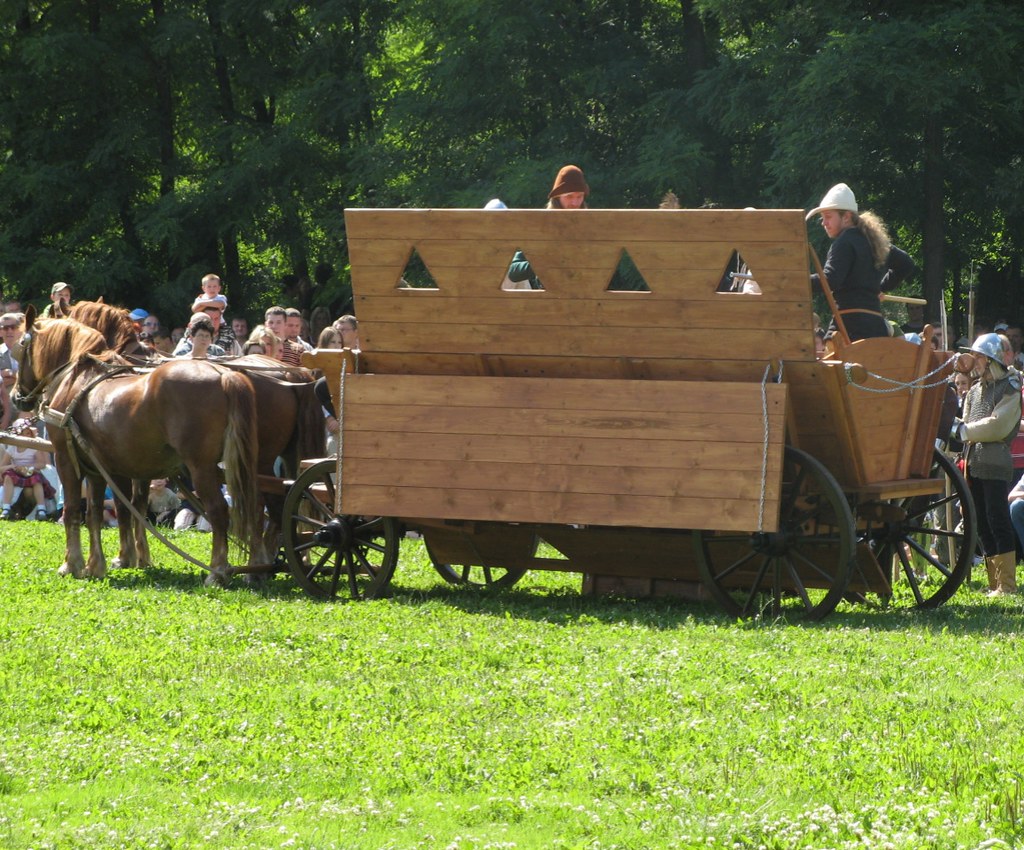
Another one: 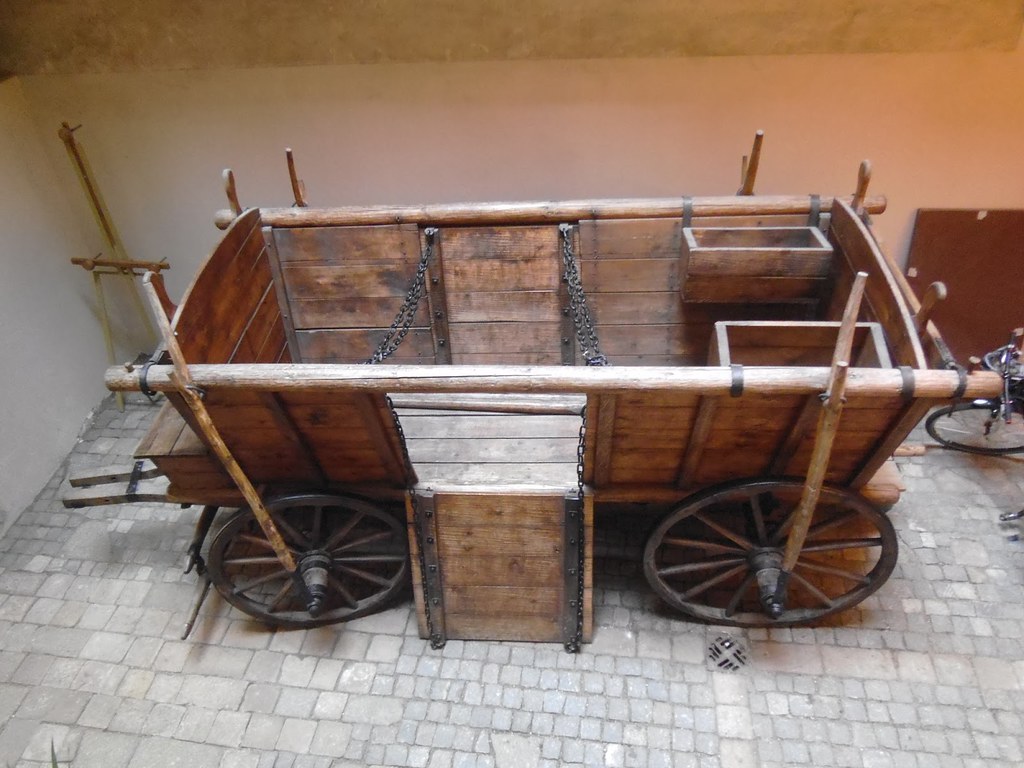
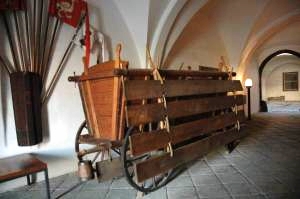
Chained together, they served as a mobile fortress. 
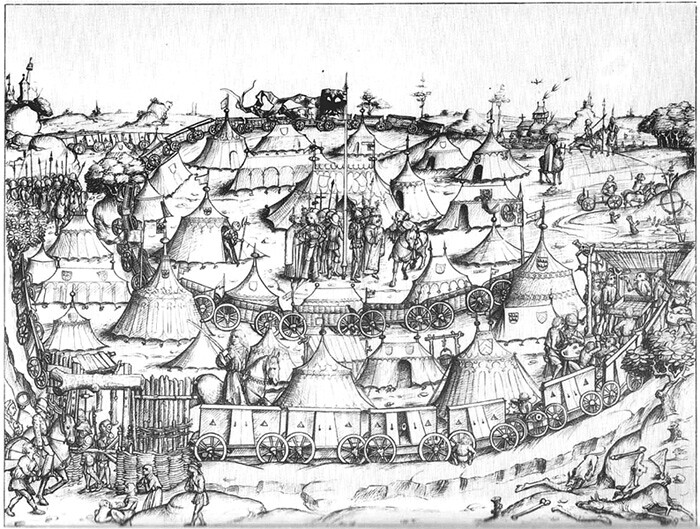
They had drop-down plates under the bottom to prevent enemy soldiers from crawling under the wagons to get inside. Depending on the terrain Hussites prepared the carts to the battle forming them in square or circle. The carts were joined by means of the chain (wheel to wheel). Therefore the carts were located aslant (their corners attached to each other) in order to allow, if necessary, to harness the horses quickly. . In front of this wall of carts a ditch was dug by camp followers. The crew of each cart consists of 18-21 soldiers: 4-8 crossbowmen, 2 handgunners, 6-8 soldiers equipped with polearms and flails (flail was Hussite "national weapon"), 2 shield carries and 2 drivers. The wagons also had a little pocket of rocks in case the soldiers ran out of ammunition.
There were two different handguns used by the Hussites. One was called the "trestle gun" (nicknamed the hook gun) and it was used as field artillery on the wagons. The trestle gun was so heavy that it required a hook to the wagon, hence its nickname. The other gun was called the pistala (from the Czech word for flute, because of its shape, possibly became the word "pistol" in English). View Quote http://allempires.com/article/index.php?q=hussite_wars 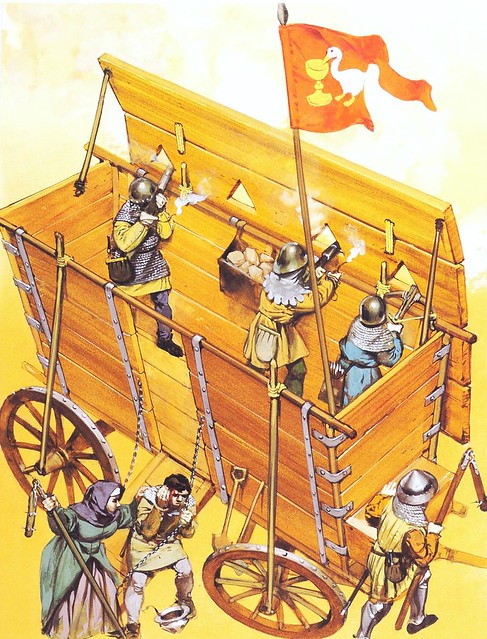
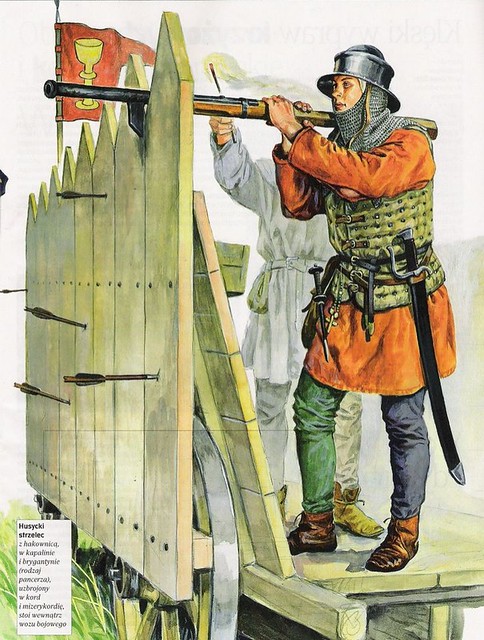
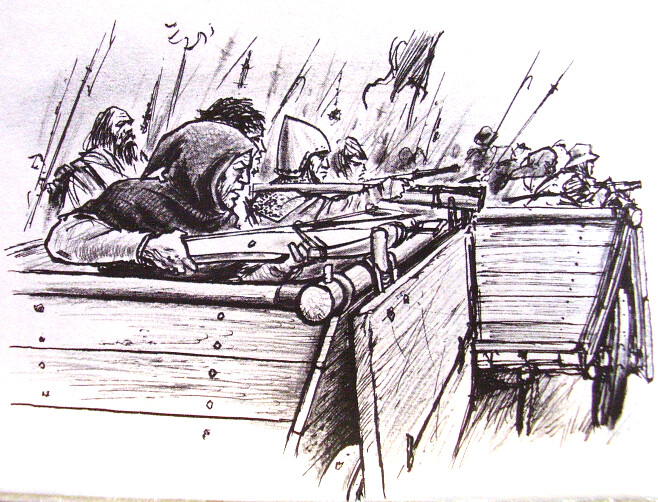
Artillery was fired through the gaps between the wagons (or they had guys there armed with pikes and halberds to stop anyone who tried to get through the gaps). 
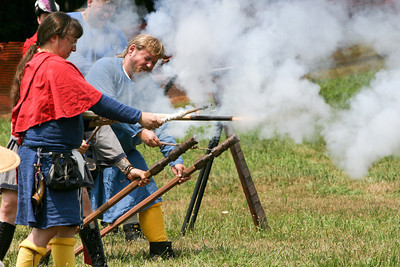
I decided to make a few video clips of myself shooting some handgonnes, including some pieces I haven't shot in a long time. I also got a bunch of pictures so you can see some detail. The videos are all live fire; powder and ball, no blank loads. In some of the clips I used a piece of burning slowmatch for ignition, in others I used a piece of fuse (not historically correct, but convenient). Handgonners often fired their pieces individually, but sometimes a second man provided the ignition, allowing the shooter to hold the gonne more securely or aim it better. Since I was doing this by myself, using a fuse allowed me to do that. I also demonstrate how these first firearms were commonly held when shooting them: under the arm, at the hip, and over the shoulder for better aim. 
But first a little spelling and pronunciation. Why 'handgonne', and how do you pronounce it? The simple answer is it's pronounced the same as 'handgun.' 'Guns' at first referred to cannons, then also to the handheld guns (or handguns) that were developed for the individual soldier to use. The spelling is just a product of it's time. Words back then were often spelled differently than they are today. And there was no standardized spelling back in the day. The same word was spelled differently depending on who was writing it. The word 'gun' was spelled gonne, gone, gunne, gunn, and probably several other variations. Sometimes people today will see the funny spelling and think they need to give it a fancy pronunciation. But if you can say 'handgun', that's all you need to say. The reason we use the old spelling today is simply as a way to differentiate this type of handgonne... 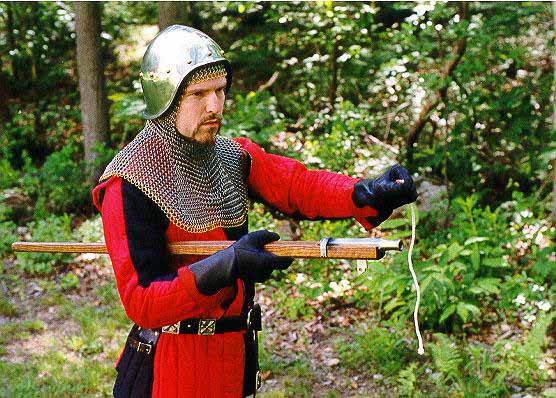
...from this type of handgun. 
The earliest European handgonnes were generally of two types. You had the type that was basically a tube on a stick (the stick was called the tiller): 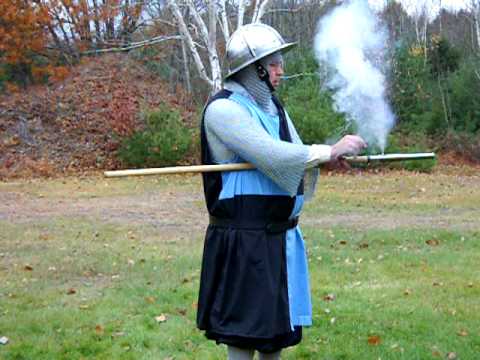

(This one had some firepower) 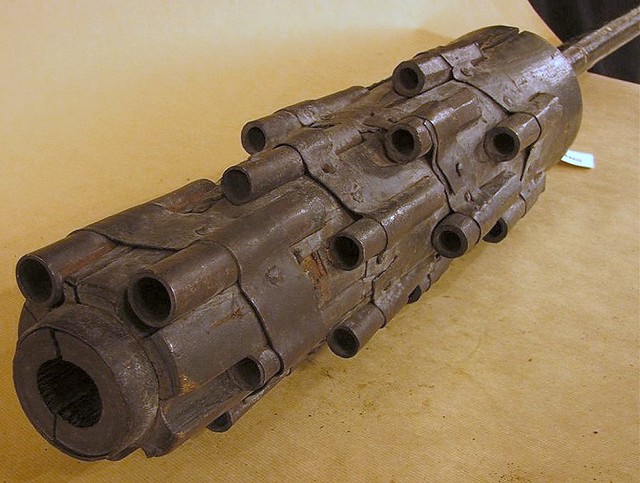
The other type had the barrel strapped to a larger, heftier tiller: 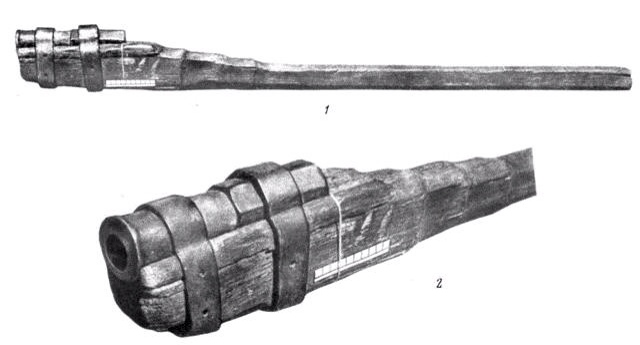
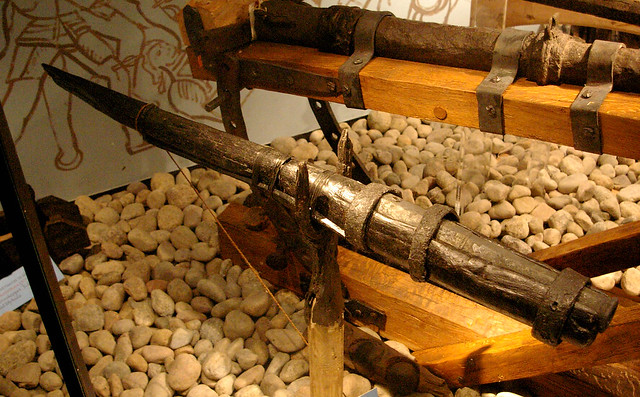
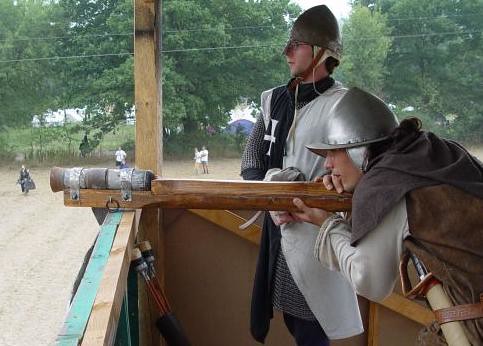

There was also the hackbut (from the earlier 'hackenbüsche', or hook gun). Both types of handgonnes were made this way. It had a hook on the bottom. When shooting over a barrier such as a shield or wall, the gonne was hooked over the top to kill the recoil. If the action got too close to continue reloading and shooting, you had a spiked war club. 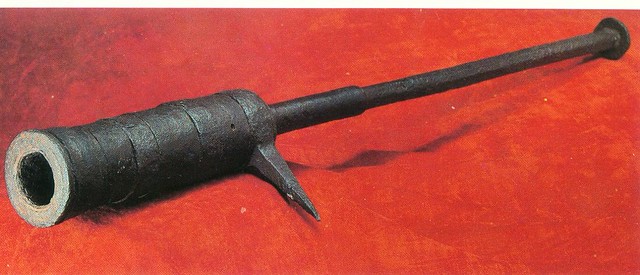

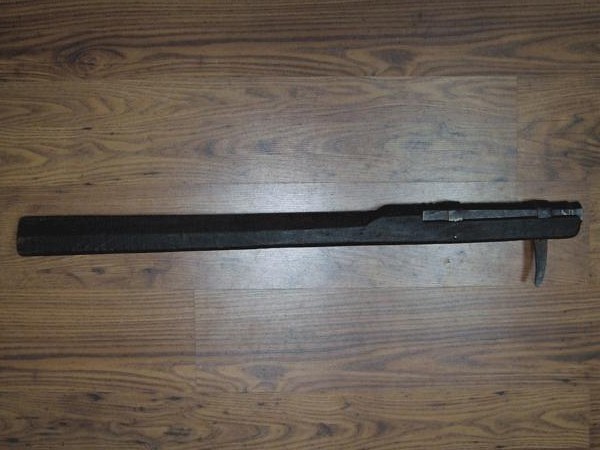
So let's get on with some shooting. The first one we have here is a very compact .50 caliber handgonne. Pretty short barrel, but it's a cool little shooter. I made a birch tiller for it. 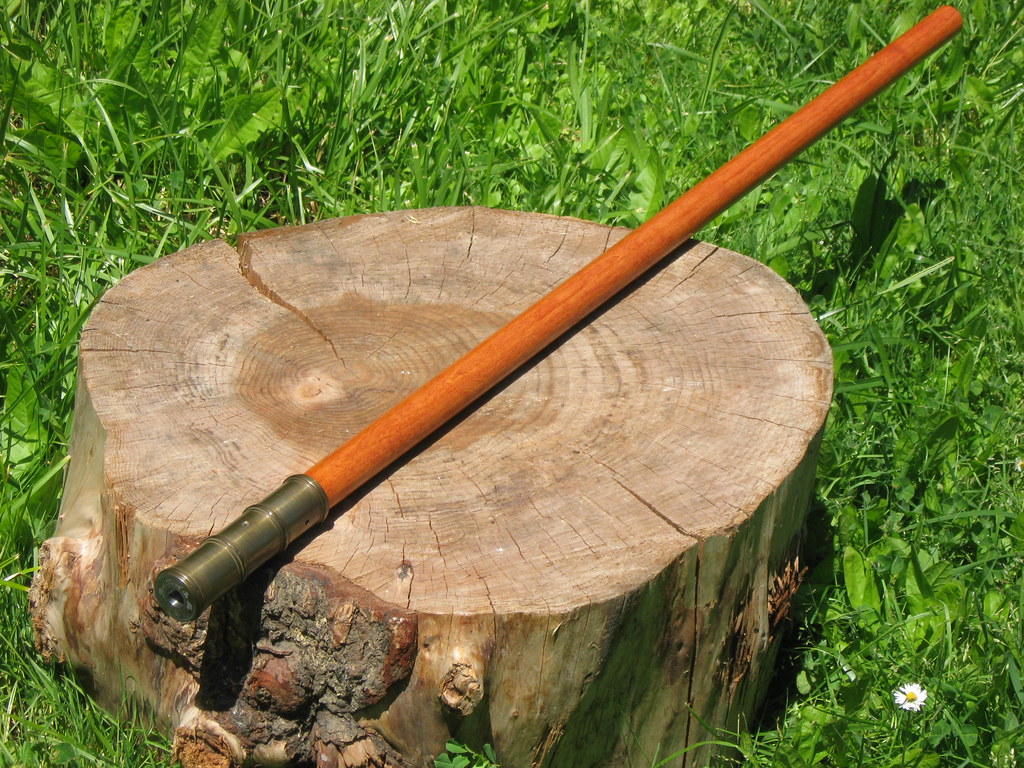
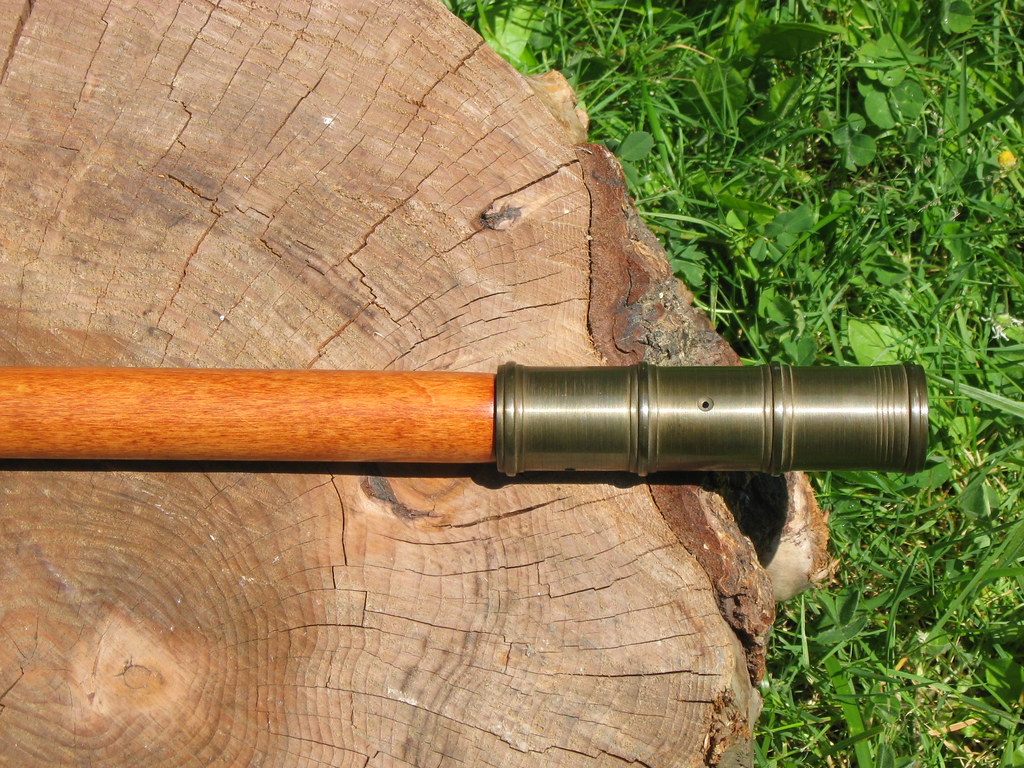
I call it the Gadsden Gonne. 
And here it is sending a ball downrange. https://youtu.be/f85wkVEHSt8  .50 caliber handgonne This one is the same as the Gadsden Gonne but without the engraving on the muzzle, and I painted it and gave it a more slender oak tiller. 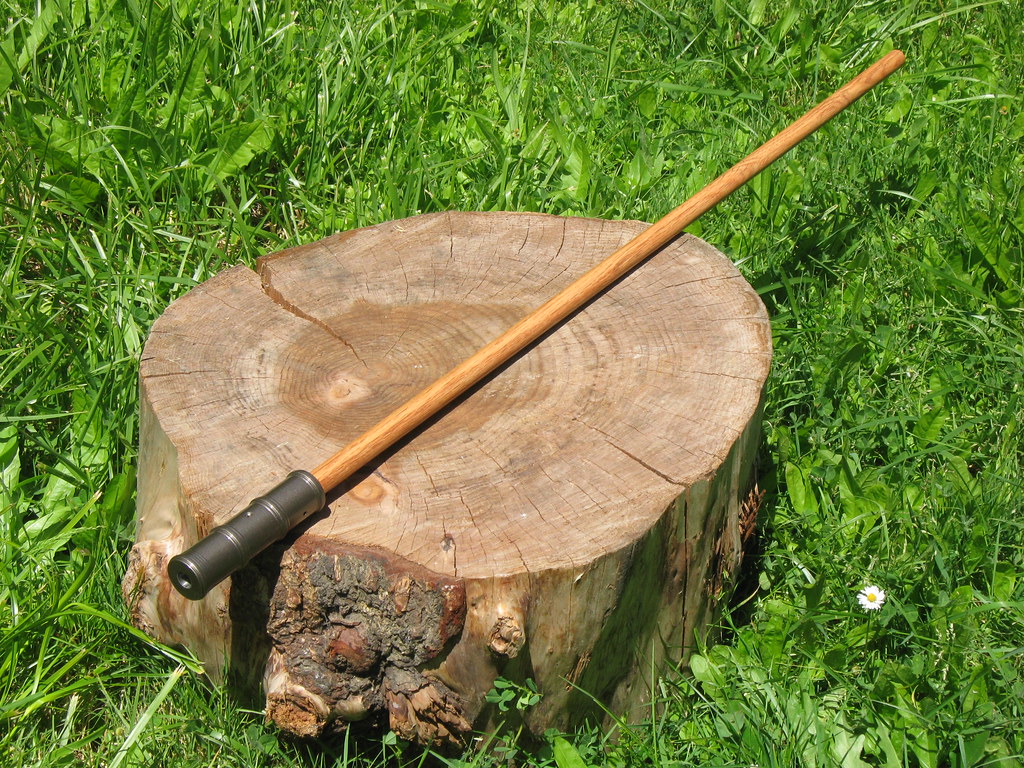
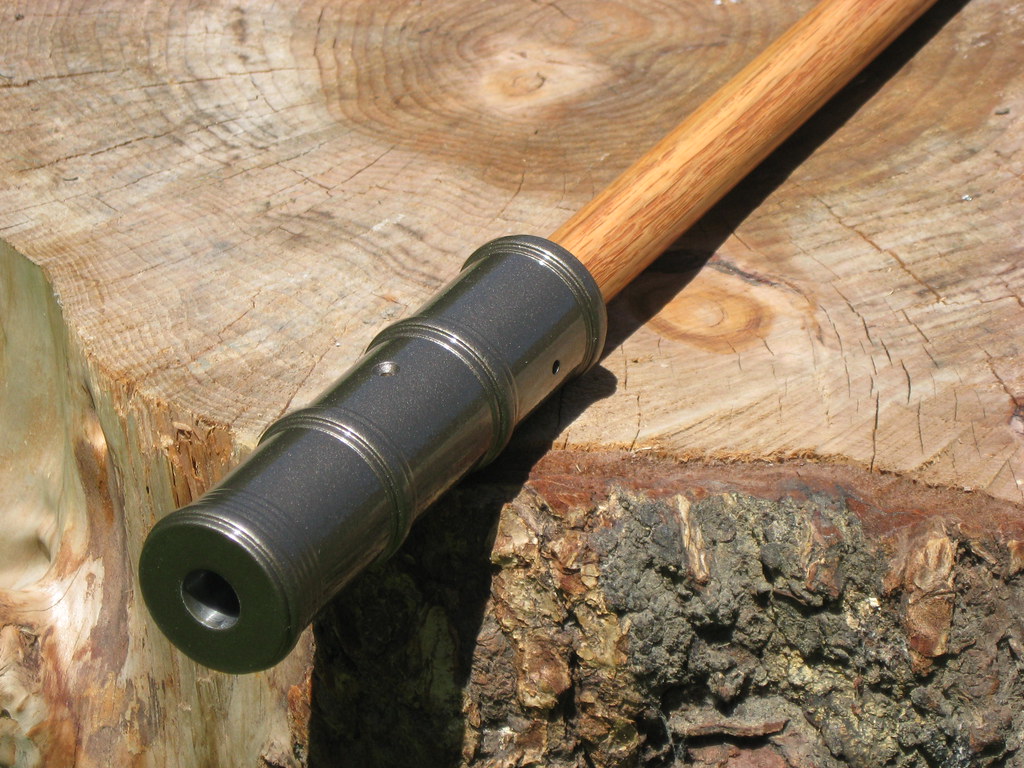
https://youtu.be/XMuQp27-k9A  .50 caliber handgonne, Part 2 Next we have a very famous piece, the Tannenberg gonne. The Tannenberg gonne is a handgonne barrel currently sitting in a museum in Germany. It was found in the ruins of Tannenberg Castle during an archeological expedition in 1849. The castle was destroyed in 1399. We know the gonne was made sometime in the 1300s, but no one knows exactly when. It was cast in bronze and has a powder chamber behind the bore. It's also a little bit beat up at both ends. Here it is as it sits in the museum: 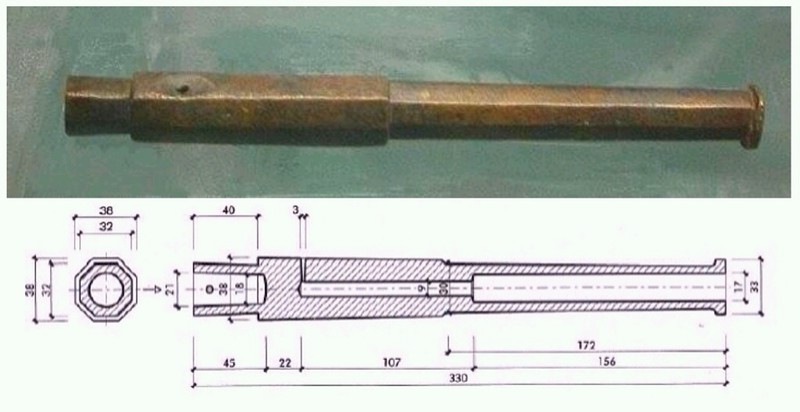


Mine is a functional exact replica of the Tannenberg gonne. I've seen some Tannenberg replicas made by individuals and they're very nice, but they're very modern. They took the measurements of the original and made a new one from steel. The lines are perfectly straight, smooth sides, perfectly machined socket and muzzle ends. Much nicer than the original ever was. Like this one: 
Mine isn't like that; it's an exact copy. It was cast in bronze like the original. It has all the same unevenness and imperfections along the sides, the banged up muzzle and out-of-shape socket opening, it even has the exact same powder chamber design inside. It was sold by the American Historical Foundation, those guys who make the commemorative guns. 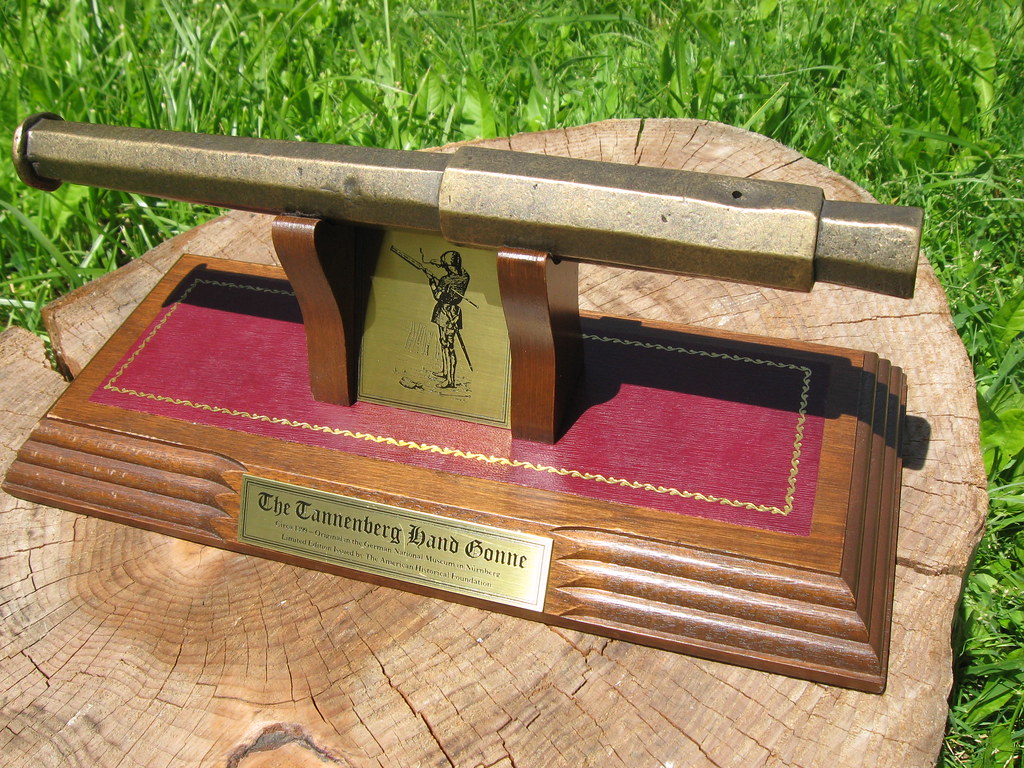

The socket, like the original, is bent out of shape a bit. 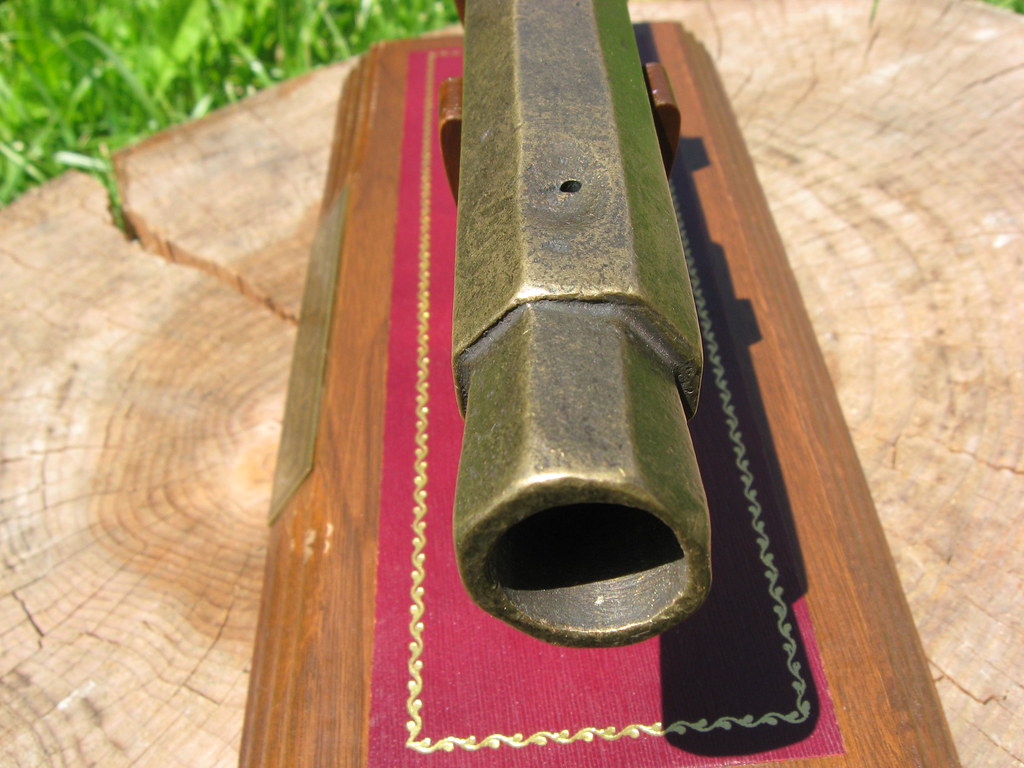
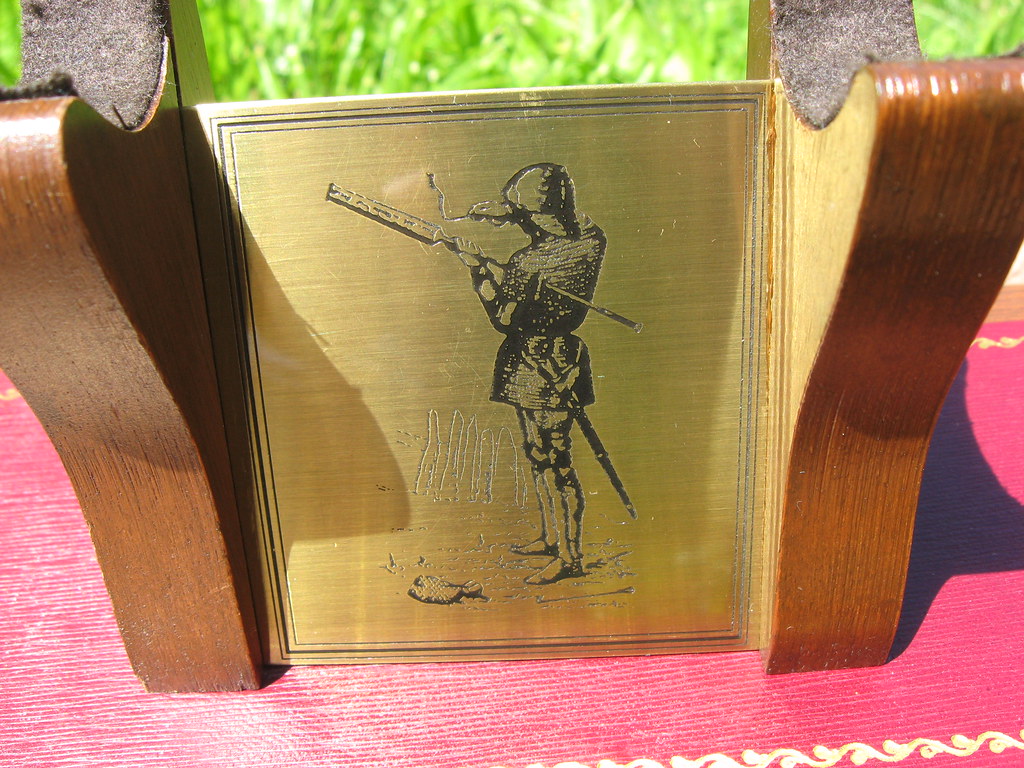
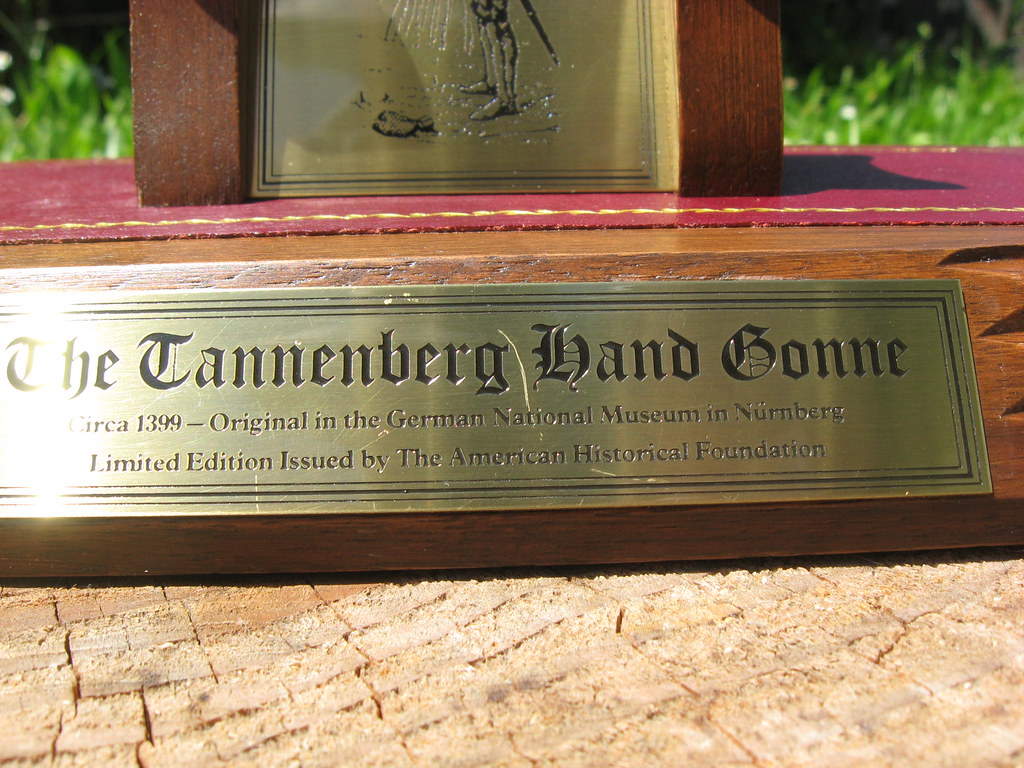
It was difficult to carve the peg on the end of the tiller to fit the socket because of it's funky shape. I was able to make it work, but due to the socket's being a bit warped, I wasn't able to get the barrel and the tiller lined up perfectly straight. But it's close enough, and it holds securely enough to work. I made the tiller from pine. 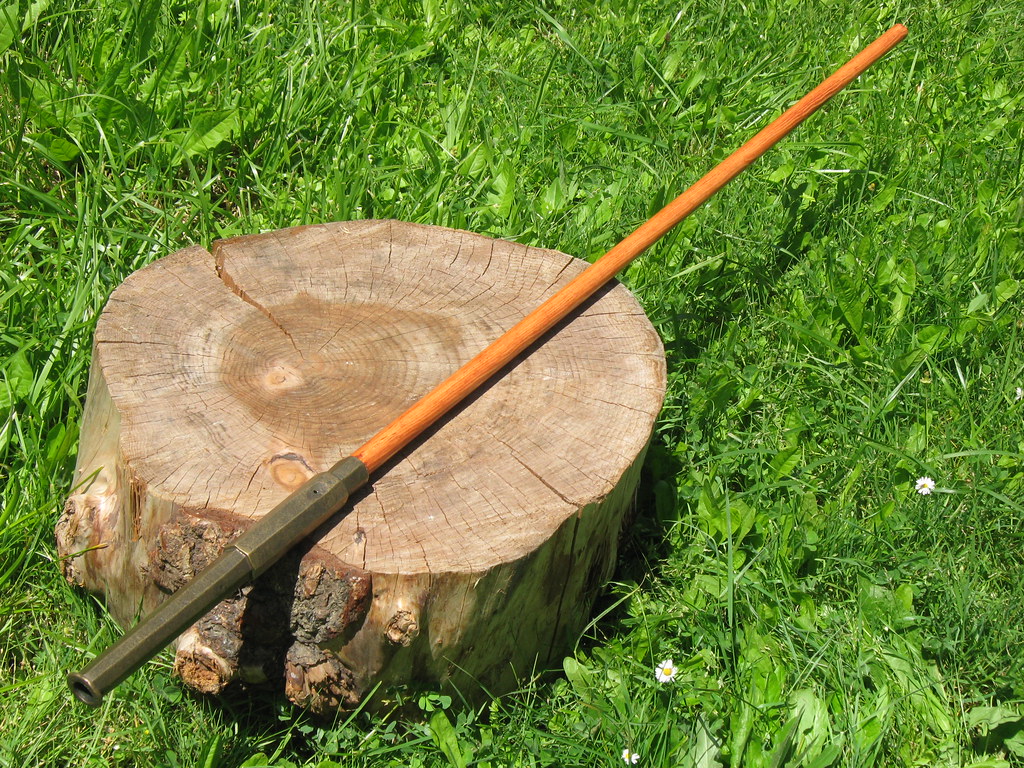
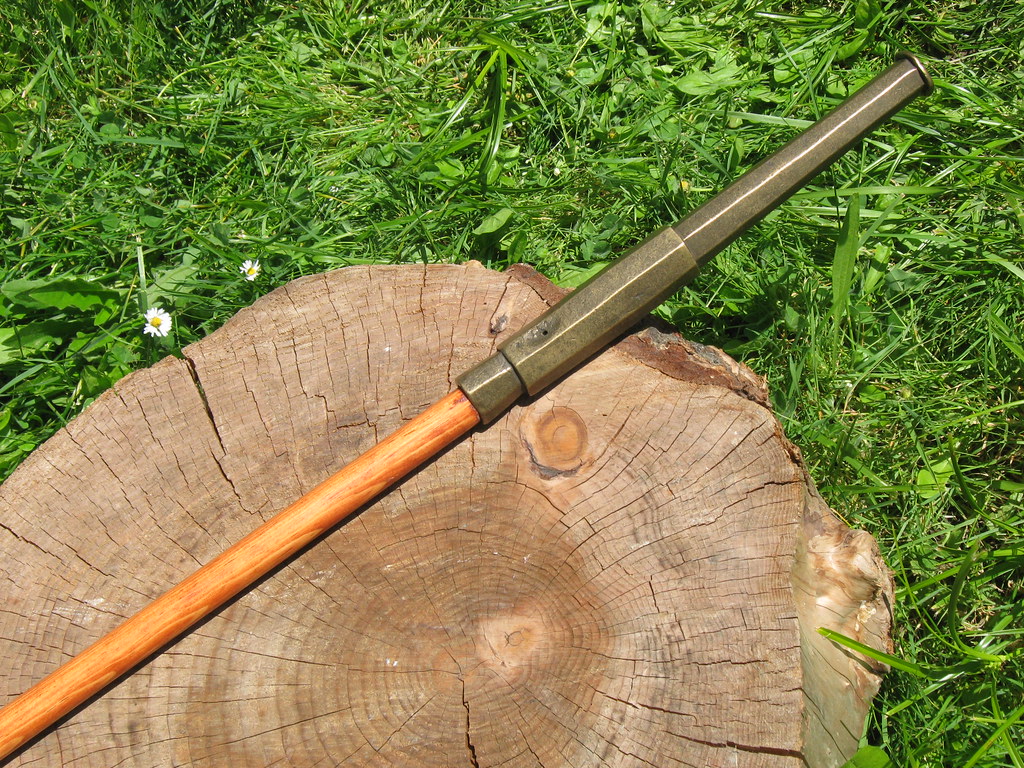
Here's where it gets interesting. The barrel was manufactured in Germany. There are some stamps on one of the lower flats. 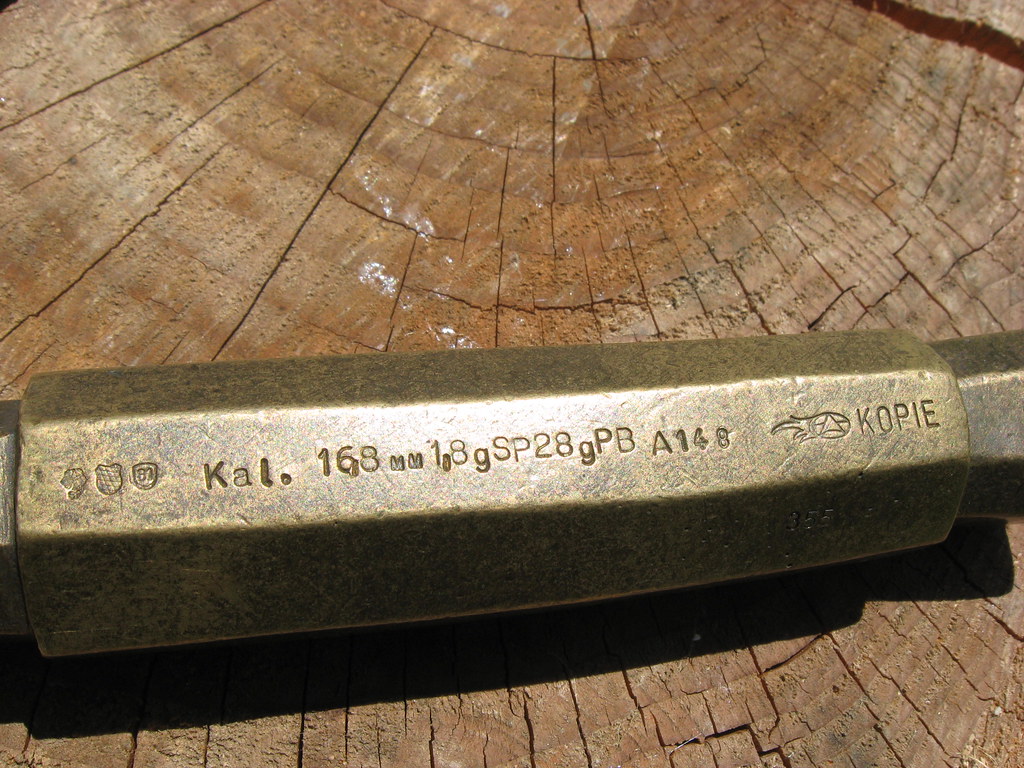
It shows what I think are proof marks, a manufacturer's mark, and the word 'copy' in German. The "kaliber" is stamped 16.8mm, which = .66 caliber, although it showed closer to .68 when I measured it. And there are a series of letters and numbers. With the help of google translate and doing some measurement conversions, I believe these give a recommended maximum load of 1.8 grams or 28 grains of blackpowder. A little experimenting with my powder measure shows the chamber holds 80 grains of powder when it's full. So how do we account for the discrepancy between the load stamped on it and how much powder the chamber holds? We have to look at the technology of the time. When this gonne was made (sometime in the 1300s), crumbled and corned powder hadn't been invented yet. They were still using a fine grained mixture called meal or serpentine powder, which burned with more of a sizzle than a boom. They had to use a bunch of it to get decent power out of their guns, more than we would need to use today with our modern blackpowder. A long slender chamber allowed them to use a good amount of their weaker (relatively speaking) powder while producing enough pressure to give that ball some oomph. I wouldn't doubt if the manufacturer erring on the side of safety was a factor as well. So the manufacturer of this replica recommends 28 grains of powder. I don't shoot this gonne frequently, and I don't feel like testing it to see how much the cast bronze barrel can take, so I go light on the load. I use just 25 grains to play it safe. That's not much for a ball that size, but it's enough to work. I filled the remaining space in the chamber with oatmeal (maple and brown sugar flavor; gimme a break, it was all I had in the cupboard) so there wouldn't be a big gap between the powder and the ball. It worked just fine. So the Tannenberg gonne comes back to life after more than six centuries, while delivering a breakfast of hot oatmeal to it's enemies. https://youtu.be/nXGgeHhECag  Tannenberg gonne Next is a hackbut handgonne (also called an arquebus at this point). I've spent the last few weeks building this one and I just finished it a few days ago. I made the hook from a railroad spike. Overall length is 36". I made the tiller from cedar. It's kind of hard to tell in the pictures but the middle part of the tiller is more rectangular while the bottom of the tail end is rounded and tapers up a bit towards the end, to make a more comfortable grip. The top part at the front tapers down to a rounded end to match the barrel contour. This isn't meant to be a copy of any particular historical piece, it's just my own creation. 
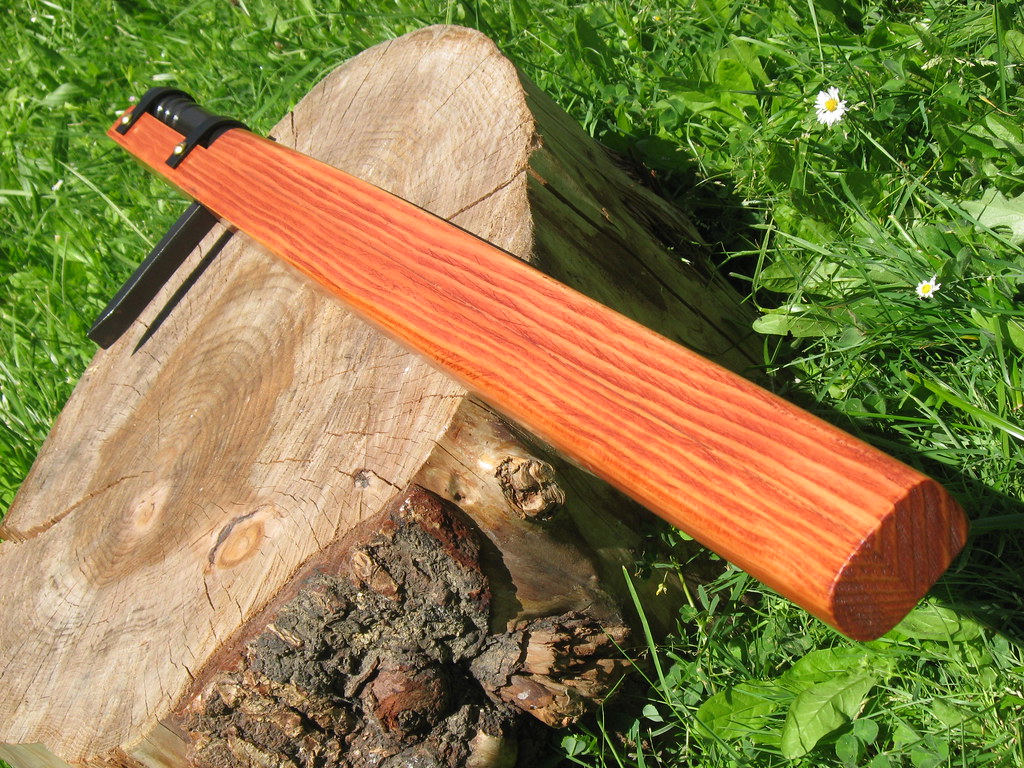

A couple of shots of yours truly holding it so you can get an idea of the size of it. 

https://youtu.be/ozaMjUxFkrE  Handgonne / arquebus Now we move up to the big leagues. This one is a .75 handgonne. The tiller is ash, which was originally a staff that I bought in a martial arts store in China Town in Seattle. It was for my kids who were training in martial arts at the time, but it was too heavy for them, so I put it to good use as a boom stick. But I'll probably replace it; a large heavy barrel like this one needs a larger tiller. 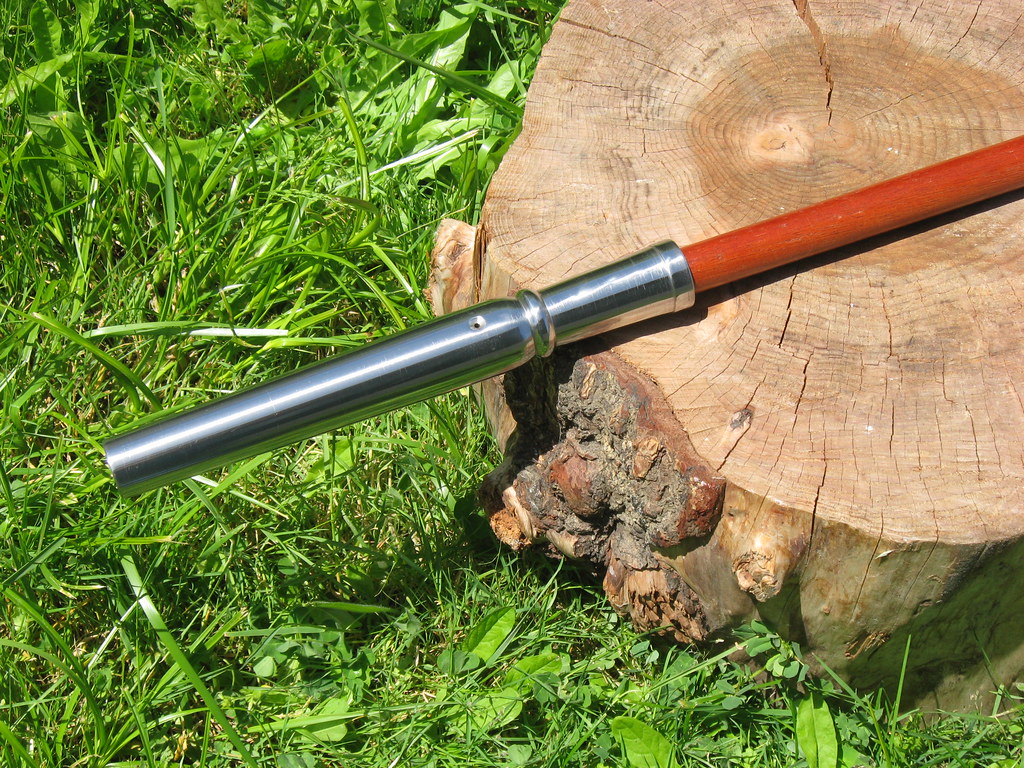
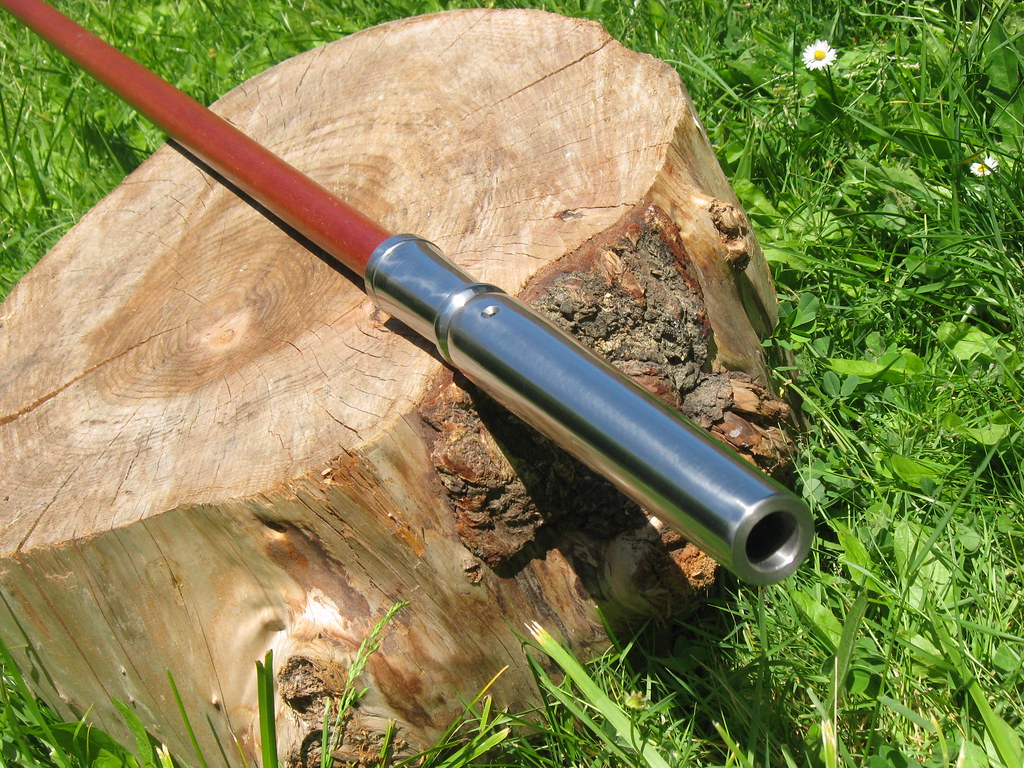


https://youtu.be/2-D6LEi73vM  .75 caliber handgonne Now for something a little different. This illustration had a lot to do with it: 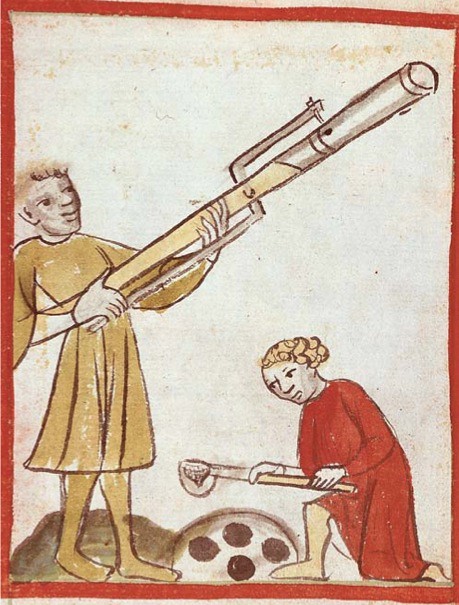
That picture is from a manuscript dated 1411. It's the earliest known illustration of any type of handheld firearm that uses a trigger mechanism. It's a very simple affair, just a long S-shaped (or serpentine) lever that pivots in the middle (either attached to the side of the tiller or running through a slot in the center of it; it was done both ways). One end has a piece of burning slowmatch clamped in it. Lift up on the bottom end of the lever to lower the match to the touch hole and boom. Very primitive, but it was the first trigger. Prior to that, ignition was provided by a separate means (applying a match or some other separate heat source by hand). This is my (loosely based) version of that serpentine matchlock gonne (although technically not a 'lock' as most people use the word today). It's .75 caliber; overall length is 74" (4" taller than I am). The tiller is hemlock. 

This gonne has already seen action in the hands of my two boys who proved to be very capable handgonners. They would have done well in the 15th century. 

https://youtu.be/xpdYaglEvJ8  .75 serpentine handgonne Last is the arquebus. Sometime in the early 1400s, corned powder came along. It was more powerful and gave the handgonne a real boost. That's when barrels started getting longer as they realized it meant the ball hit harder and penetrated better. The tiller was also morphing into the shape we know today as the rifle stock. The early ones had no type of trigger at all, just the barrel and tiller, as seen here: 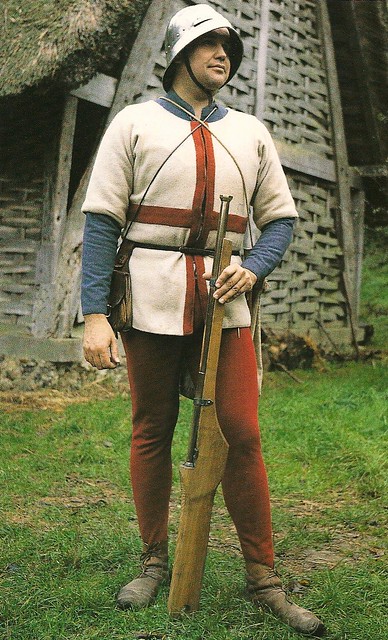
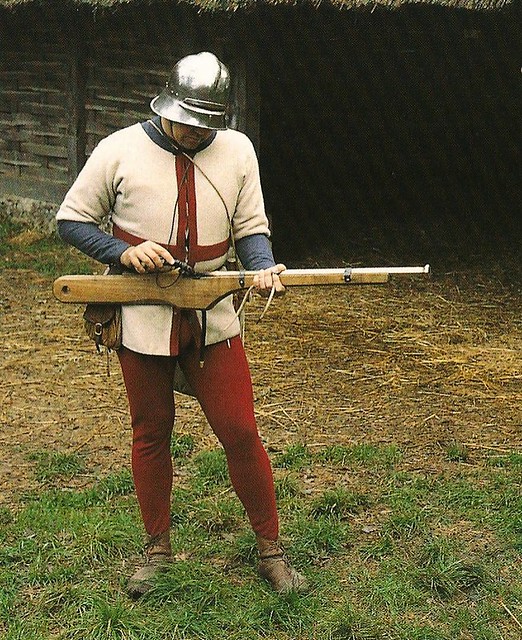
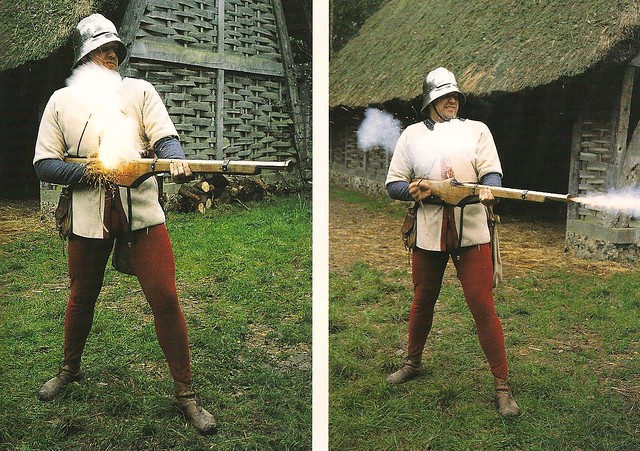
Others had a simple trigger lever as shown by the weapons used by these two arquebusiers: 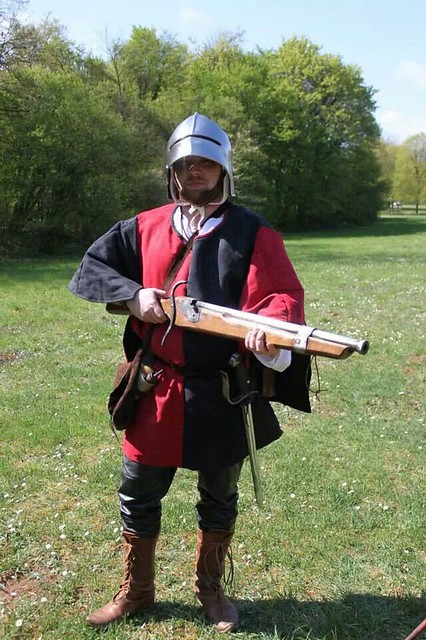

The simple ones with no trigger lever continued to be used for a time along with the ones that did have one. But eventually the simple serpentine lever had been replaced by a lock that connected the trigger and the dog (what the hammer was often called at the time) with a lever (called the sear) attached to the inside of a lock plate. This is the matchlock most people know of today. This whole transition period is when gonnes really started to look like what we know today as a gun. The arquebus was used extensively in war until it was later replaced by the larger and longer matchlock musket. A famous incident was the battle of Cerignola in 1503. The French and Spanish were duking it out. The Spanish used the layout of the terrain to their advantage and set up a good defensive position. The French cavalry attacked and found themselves slaughtered by the Spanish arquebusiers. Gunpowder in war was nothing new by then, but this was the first time the outcome of a major battle was decided by the use of handheld firearms. 
This is my .58 matchlock arquebus. 
And here it is in action. https://youtu.be/Q6NbglSKW4o  Matchlock arquebus So the handgonne has an important place in the history of guns. It led to the arquebus, the caliver, the musket, and other variations followed like the pistol, shotgun, rifle, etc. Every type of handheld firearm that we have today is descended from the handgonne. It was the original individual firearm that started it all. No gun collection is complete without one. 
Family portrait. 
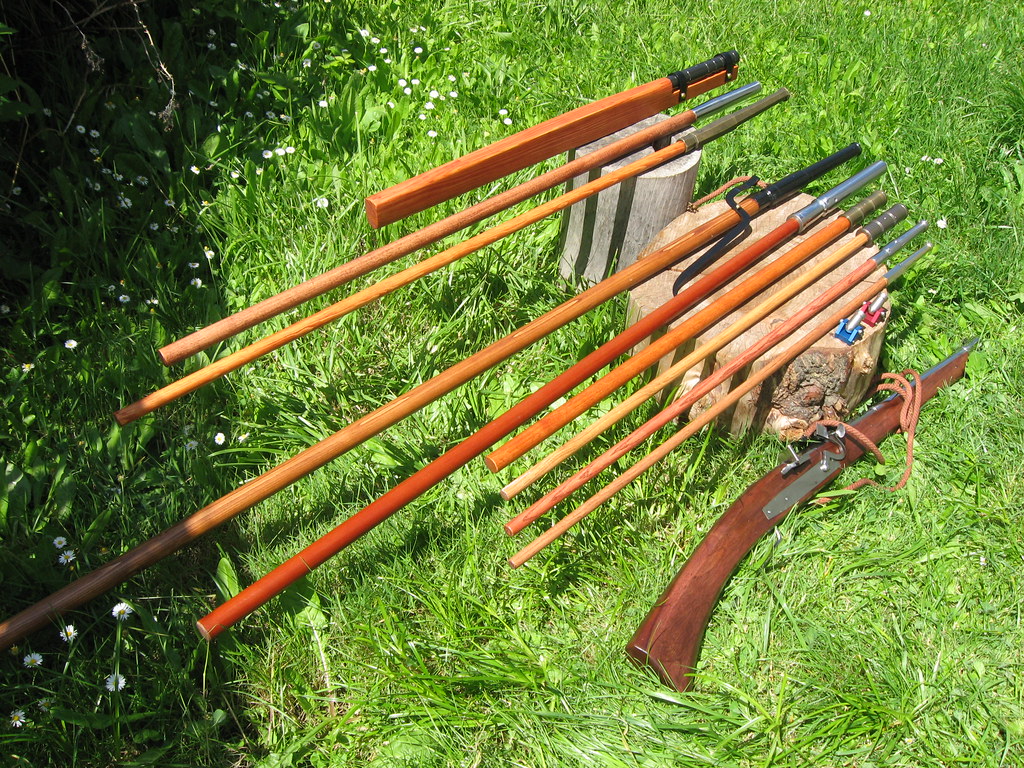
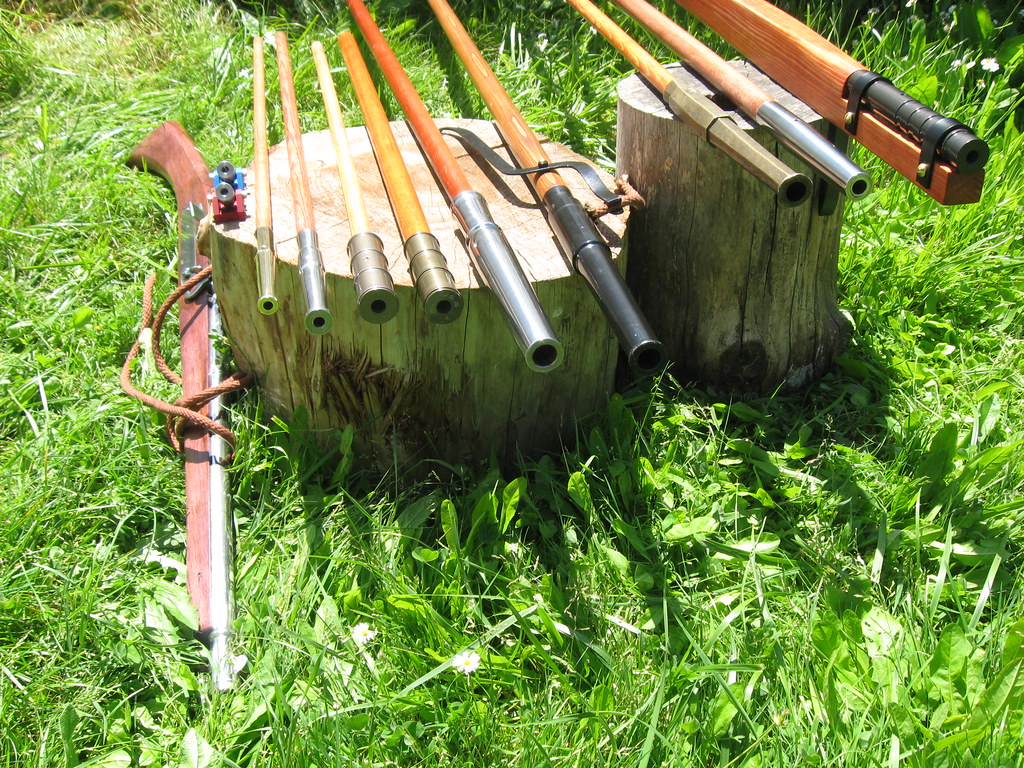
And I thought I'd put together a little primer for anyone interested in matchlocks. This short video explains how they function. https://youtu.be/WJyX-v_nYgo  How a matchlock works And here's a tutorial on making slowmatch. First you'll need some rope. The diameter will depend on the design of your gun, you'll need to measure the gap between the jaws of the serpentine to determine how thick the slowmatch should be. Hemp rope is supposed to be the best stuff for making slowmatch, and was the preferred type back in the day. The problem with it is that it's hard to find in the U.S., and when you do find it, it can cost quite a bit. It's usually imported from Europe. The next best stuff is 100% cotton rope. I prefer braided instead of twisted because it holds together well as it burns, but some people do fine with twisted rope (as with everything else involving matchlocks, you'll have to experiment to determine what works best for you). You can try sisal or manila rope from the hardware store. Different types will give different results. If you use cotton rope that has a nylon core, pull the core out first. You'll have a gooey mess if you burn that stuff. I use braided 100% cotton rope you can buy here. It's a bit expensive compared to rope from the hardware store but it's good quality stuff and performs great. I make my slowmatch in six-foot lengths. 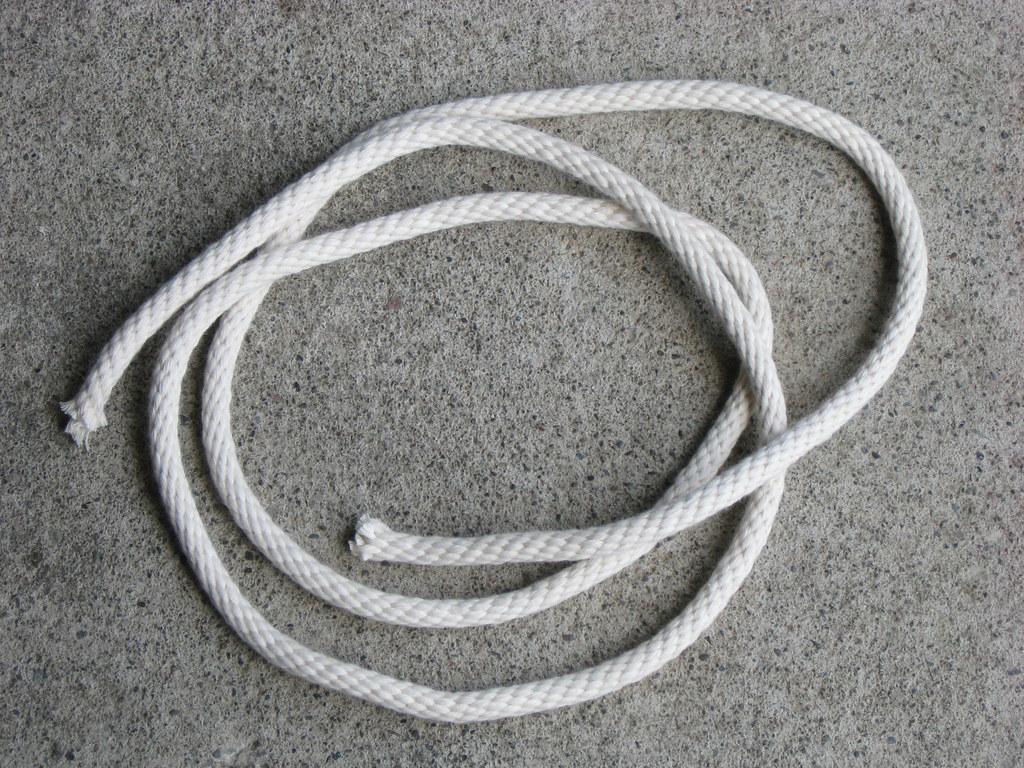

Next you need a cooking pan or casserole dish that can hold some liquid around an inch or so deep, and a BBQ/frying sheet or cookie drying rack that will fit inside the pan. 

Some potassium nitrate (a.k.a. saltpeter), which can be purchased from some hardware stores and farming/ranch supply places as KNO3/stump remover. Smaller amounts can be purchased on ebay and amazon, like this: 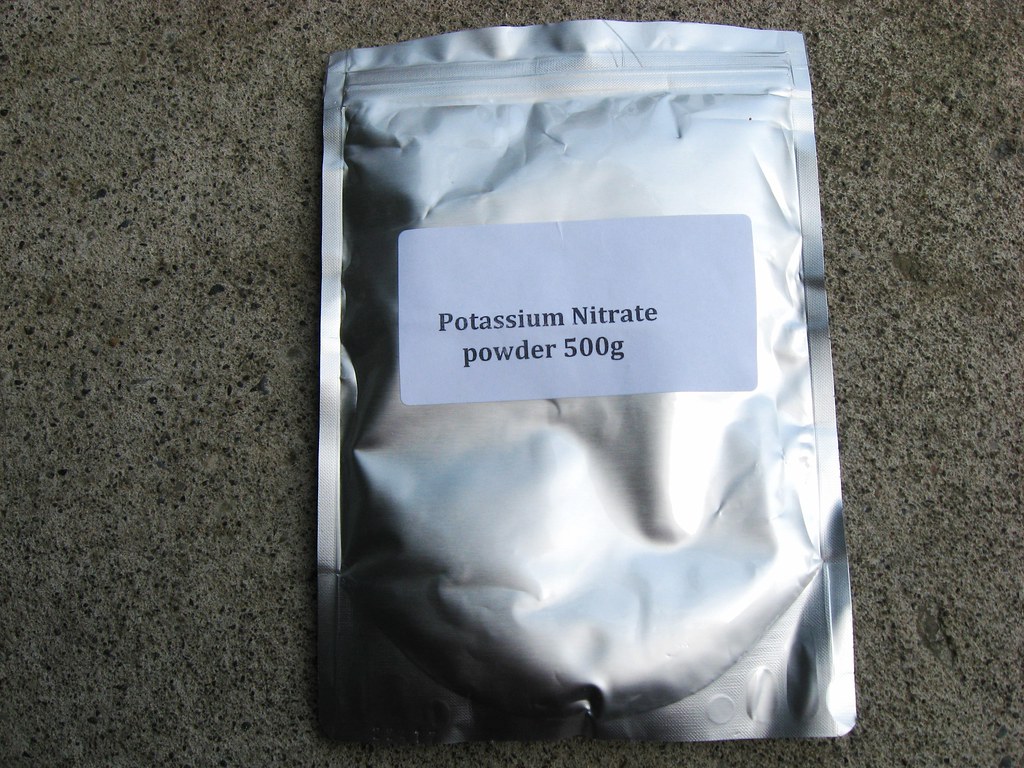
And a container to keep your solution in. I use a plastic one-gallon jar. I put a couple of layers of plastic wrap under the lid to help it make a better seal. 
First, mix your solution. Add 3 or 4 tablespoons of the saltpeter to 4 cups of water (tap water is fine). Again, experiment with the amounts to figure out what works best for you (different types of rope may require different concentrations of saltpeter). I like to add a little brown Rit dye to the mix so the match comes out brown. It's not necessary but I think it looks better than a bright white match. I've heard of using blackpowder instead of saltpeter. Potassium nitrate is one of the ingredients of blackpowder. You can mix blackpowder in the water; it will dissolve and the rope will absorb the saltpeter while the other ingredients remain in the water. I haven't tried it (I prefer to use my supply of blackpowder for shooting), so I can't recommend how much to use. Again, you'll have to experi... well, you know. Put the lid on the container and shake to mix it. Pour enough solution into the pan to make sure the rope will be completely covered by the liquid (it will be foamy for a minute after shaking it up). 
Then put the rope in. 
The rope needs to remain completely submerged while it's soaking. If it's allowed to float, parts of the rope will be above the surface and they won't absorb the magic. You'll have spots that will burn like they should and spots that won't. This is where your BBQ/frying sheet or cookie drying rack comes in handy. Lay it on top of the rope to hold it under the surface. 
It should be heavy enough to hold the rope under. If not, just put something on it to weigh it down. 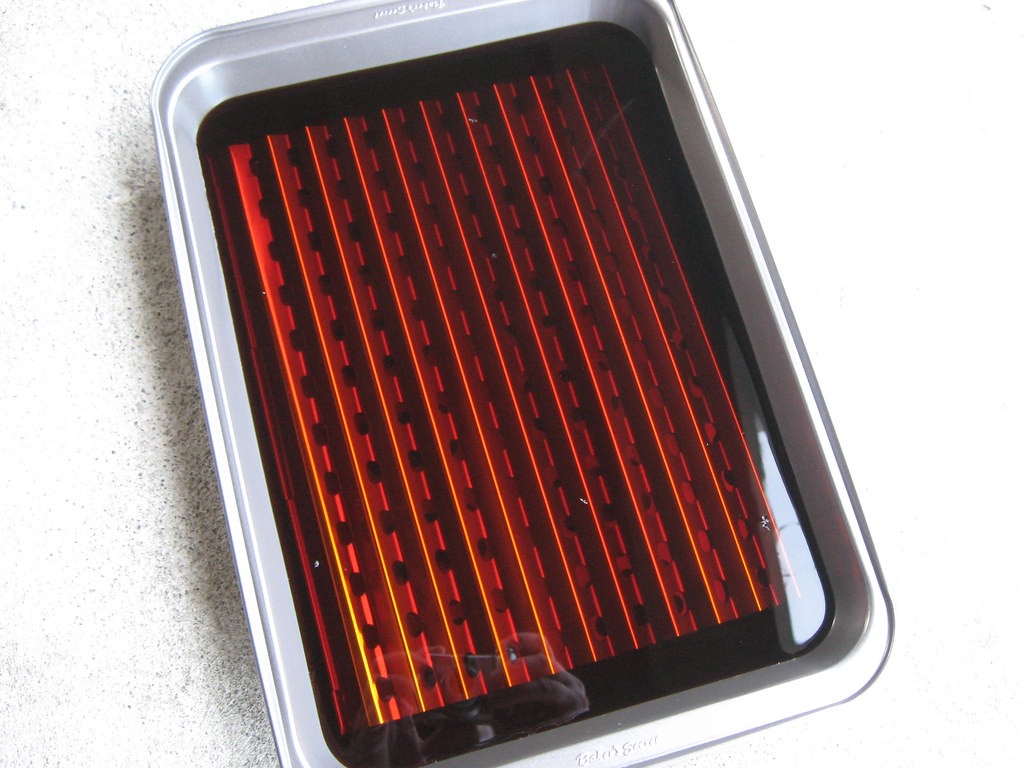
Now let it soak. An hour and a half or so works well for me. The match burns slowly but consistently and isn't easily extinguished. I tried soaking a piece for eight hours but it was too much. The more saltpeter it was allowed to absorb means it burns well but a little too fast. I can still use it but I have to adjust it in the jaws of the serpentine more frequently as it burns down faster. I can actually see a little white crusty stuff (the saltpeter) on the surface of the match because it absorbed so much. The length of time for soaking can also depend on how much saltpeter you added. A stronger concentration may not require as much soaking time, and vice versa. When it's done soaking, take it out of the solution. Don't squeeze the excess liquid out of it, just hold it up for a few seconds to let the excess fluid run off and then lay it on a flat surface to dry. 
Don't hang it up to dry. If you hang it over something, the solution will run down to the ends and you'll have a higher concentration at the ends that will burn stronger and a weaker concentration in the middle. Lay it flat to dry and it will burn consistently. It will dry faster if you can put it out in the sun. Put the rest of the solution back in the container and put it in the fridge. You can use it again when you're ready to make another piece. When it's dry, it's done. Your rope is now slowmatch. Light the end to watch it slowly burn while marveling at how they figured out how to do this stuff 700 years ago. As it's burning and putting off a tiny wisp of smoke, the end will look black and burnt, like this: 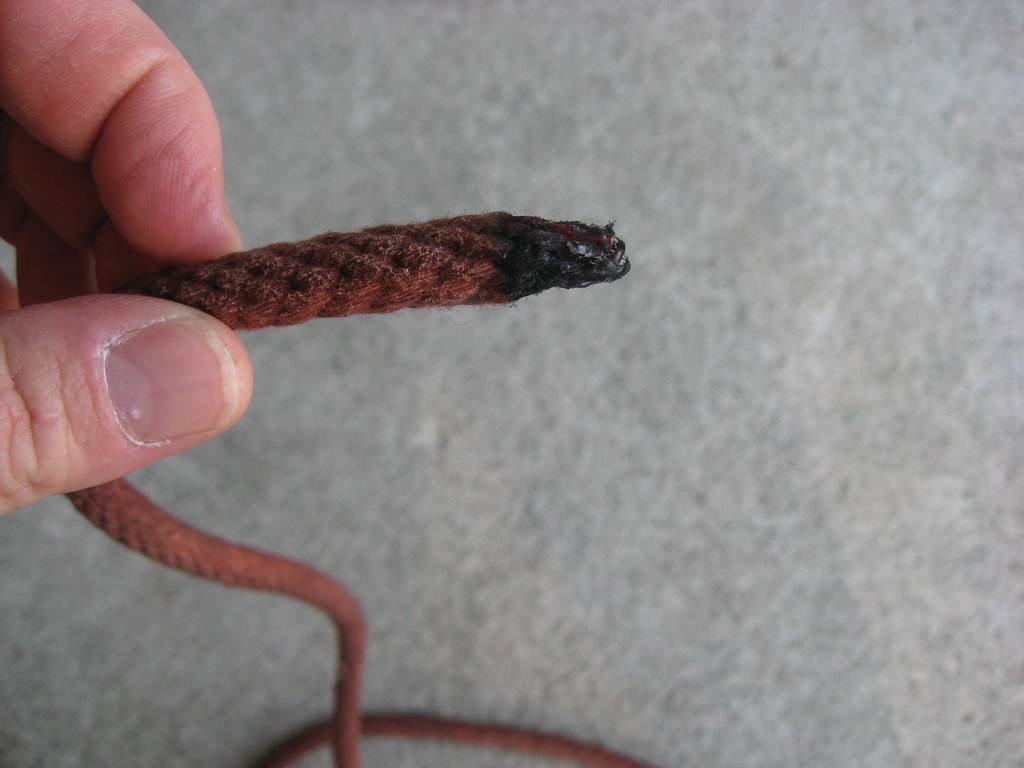
When you blow on it to blow off the excess ash and make sure you've got a strong, hot coal on the end before shooting, it will glow strongly like this: 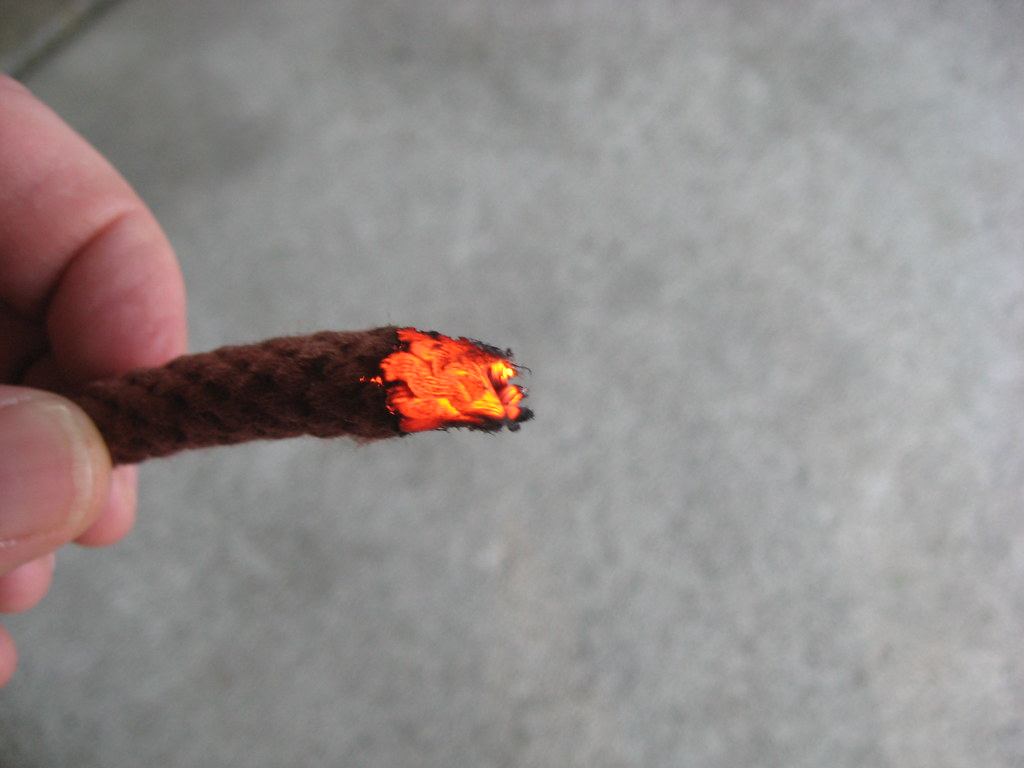
It's now ready to shoot. I've found it's not easily extinguished (as long as it doesn't get wet). The potassium nitrate wants to keep burning. I've tried putting it out by squashing the end under something, thinking I could simply smother it, but no such luck. That stuff keeps burning despite my best efforts to smother it. The only way I could put it out that way is to actually crush the end with something while tearing off the burning fibers before it can burn any further. I was able to do it but it wasn't easy and the end was a frazzled mess afterwards (not that it matters; that won't prevent you from lighting it again next time). If you want to put it out without making a mess of the end, I've found the simplest way is to just dip the end in water or pour water over it. That extinguishes it instantly while preserving the black burnt end (looks better in pictures than if it has a frazzled end), and it will burn just fine after it's had time to dry out. Or you could just keep a sharp knife or scissors handy and cut the burning end off. Now go shoot something. 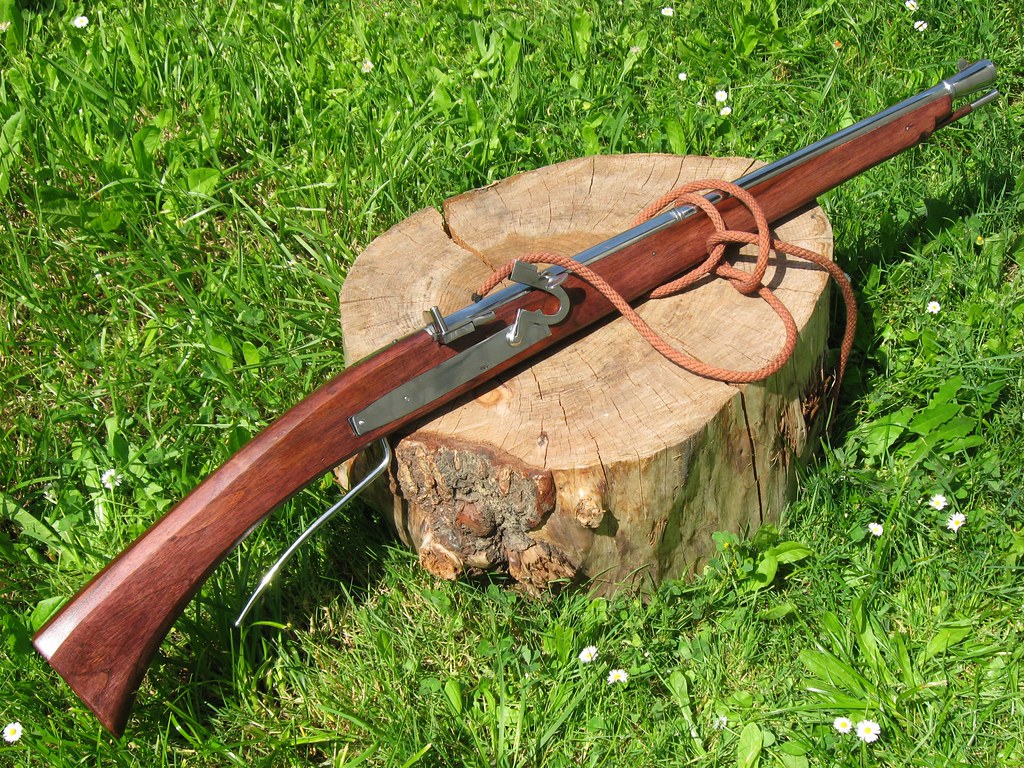
A few pictures and videos of my boys doing some shooting. It was their first time shooting a couple of the guns we shot that day. 




https://youtu.be/-NXxDBvWxO0  Failed To Load Title https://youtu.be/rXZHr8EBJSE  Failed To Load Title https://youtu.be/2IhXFmxbcrY  Failed To Load Title |
|
|
|
Please shoot them at a 1/2 " pine board.
Love to see what the board will look like. |
|
|
|
<medievaldemocrat>Forsooth be it needful, a ban 'gainst yon hande-thingge, which goeth back, and so giveth foul lowborn knaves the wherewithal to smite so grievously 'pon gendarmes and tender babes!<\medievaldemocrat>
|
|
|
|
Terrific post Smashy!
|
|
|
|
This is a great post and love the history lesson with the actual pieces! Thank you!
|
|
|
|
I believe there are a few original examples up for auction at the Dan Morphy auction this month.
|
|
|
|
Awesome stuff. Thanks.
I still need a wheel lock for my collection |
|
|
|
Thank you for the history and firsthand insight, sir! That is one of the most interesting topics I've seen posted in quite some time, anywhere.
|
|
|
|
I always have loved these threads....never stop with the boom sticks
|
|
|
|
Quoted:
<medievaldemocrat>Forsooth be it needful, a ban 'gainst yon hande-thingge, which goeth back, and so giveth foul lowborn knaves the wherewithal to smite so grievously 'pon gendarmes and tender babes!<\medievaldemocrat> View Quote lol I heard that in a deep Shakespearean voice as I read it and it was great! |
|
|
|
This is the kind of post (and poster) that makes AR15.com shine!
Thanks, OP. |
|
|
|
Quoted:
I believe there are a few original examples up for auction at the Dan Morphy auction this month. View Quote That would be cool but my money is tied up in other things now. I had plans several months ago to build a hand mortar that shoots golf balls, but it kept getting put on the back burner and never happened. I might still try to get that going. |
|
|
|
Still fascinating the second time time around. I'd like to try it.
|
|
|
|
Actually those "hooks" underneath were used primarily as a weapon spike rather than recoil.
The heavy barrel end with a spike under all that weight would act like a war pick or hammer when it hit, and you wouldn't have to drop the gun to pull out a sword or something. These don't have much recoil at all. |
|
|
|
Quoted: That would be cool but my money is tied up in other things now. I had plans several months ago to build a hand mortar that shoots golf balls, but it kept getting put on the back burner and never happened. I might still try to get that going. View Quote A golf ball won't do nuthin' to a cat. You need a larger ball: http://www.buckstix.com/CoehornMortarHunt.htm 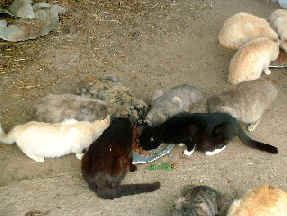
(Cats in the beaten zone) |
|
|
|
One cool aspect of those "primitive" firearms is that you can beat the crap out of the enemy with them if your shot misses.
|
|
|
|
Quoted:
A golf ball won't do nuthin' to a cat. You need a larger ball: http://www.buckstix.com/CoehornMortarHunt.htm http://www.buckstix.com/images/cat9.jpg (Cats in the beaten zone) View Quote View All Quotes View All Quotes Quoted:
Quoted: That would be cool but my money is tied up in other things now. I had plans several months ago to build a hand mortar that shoots golf balls, but it kept getting put on the back burner and never happened. I might still try to get that going. A golf ball won't do nuthin' to a cat. You need a larger ball: http://www.buckstix.com/CoehornMortarHunt.htm http://www.buckstix.com/images/cat9.jpg (Cats in the beaten zone) LOL |
|
|
|
Thanks for taking the time and effort to make that post. Very interesting!
|
|
|
|
Quoted:
A golf ball won't do nuthin' to a cat. You need a larger ball: http://www.buckstix.com/CoehornMortarHunt.htm http://www.buckstix.com/images/cat9.jpg (Cats in the beaten zone) View Quote Yeah, that page is pretty funny. That picture of the cat  always reminded me of this smiley: always reminded me of this smiley: 
Here's another page about hunting deer with a howitzer: http://www.buckstix.com/howitzer.htm |
|
|
|
Quoted: Yeah, that page is pretty funny. That picture of the cat http://www.buckstix.com/images/headshot.jpg always reminded me of this smiley: 
Here's another page about hunting deer with a howitzer: http://www.buckstix.com/howitzer.htm View Quote I don't know that we can't hunt deer w/ a howitzer in Texas - but I know we could use one to hunt hogs @ night. 
|
|
|
|
One of the best posts on Arfcom in a long, long time.
You win! |
|
|
|
|
|
I kinda want an arquebus now...
But if I ever get into black powder, I'd rather have an 8ga boarding gun. |
|
|
|
|
 Win a FREE Membership!
Win a FREE Membership!
Sign up for the ARFCOM weekly newsletter and be entered to win a free ARFCOM membership. One new winner* is announced every week!
You will receive an email every Friday morning featuring the latest chatter from the hottest topics, breaking news surrounding legislation, as well as exclusive deals only available to ARFCOM email subscribers.
AR15.COM is the world's largest firearm community and is a gathering place for firearm enthusiasts of all types.
From hunters and military members, to competition shooters and general firearm enthusiasts, we welcome anyone who values and respects the way of the firearm.
Subscribe to our monthly Newsletter to receive firearm news, product discounts from your favorite Industry Partners, and more.
Copyright © 1996-2024 AR15.COM LLC. All Rights Reserved.
Any use of this content without express written consent is prohibited.
AR15.Com reserves the right to overwrite or replace any affiliate, commercial, or monetizable links, posted by users, with our own.

